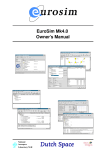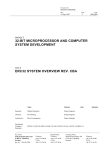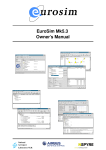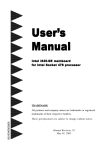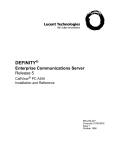Download report
Transcript
ERC32 Tool Set Evaluation CRI Doc. no.: CRI/ERC32/TN/001 Date: 27.06.97 Issue: 1 Revision: - Distribution: ESTEC, CRI Prepared by: Christian Maegaard Approved by: Lars Behrendt - QA Authorised by: Carsten Jørgensen ERC32 Tool Set Evaluation June 1997 c COMPUTER RESOURCES INTERNATIONAL A/S, 1997. The copyright of this document is vested in Computer Resources International A/S. This document may only be reproduced in whole or in part, stored in a retrieval system, transmitted in any form, or by any means electronic, mechanical, photocopying, or otherwise, with the prior permission of Computer Resources International. CRI/ERC32/TN/001/1 iii Document Change Record Issue Date Change 1 27.06.97 Initial issue of document Document Status Sheet Page Issue i–vi 1–22 1 1 CRI/ERC32/TN/001/1 iv Table of Contents 1 Introduction 1.1 Scope . . . . . . . . . . . . 1.2 Abbreviations and Acronyms 1.3 Terms and Definitions . . . . 1.4 Document Outline . . . . . . . . . . 1 1 2 2 2 2 Document References 2.1 Applicable Documents . . . . . . . . . . . . . . . . . . . . . . . . . 2.2 Reference Documents . . . . . . . . . . . . . . . . . . . . . . . . . . 3 3 3 3 Evaluation Overview 4 4 AdaWorld Compiler System for ERC32 4.1 Description . . . . . . . . . . . . . . . . . . . 4.2 Porting Experiences . . . . . . . . . . . . . . . 4.3 Delay Until . . . . . . . . . . . . . . . . . . . 4.4 Passive Tasks . . . . . . . . . . . . . . . . . . 4.4.1 Immediate Priority Ceiling Inheritance 5 5 5 6 7 8 . . . . . . . . . . . . . . . . . . . . . . . . . . . . . . . . . . . . . . . . . . . . . . . . . . . . . . . . . . . . . . . . . . . . . . . . . . . . . . . . . . . . . . . . . . . . . . . . . . . . . . . . . . . . . . . . . . . . . . . . . . . . . . . . . . . . . . . . . . . . . . . . 5 WCETE for ACS 10 5.1 Description . . . . . . . . . . . . . . . . . . . . . . . . . . . . . . . 10 5.2 Evaluation . . . . . . . . . . . . . . . . . . . . . . . . . . . . . . . . 10 6 Schedulability Analyzer 6.1 Description . . . . . . . . . . . . . . 6.2 Evaluation . . . . . . . . . . . . . . . 6.2.1 Describing the System Model 6.2.2 Performing the Analysis . . . . . . . . . . . . . . . . . . . . . . . . . . . . . . . . . . . . . . . . . . . . . . . . . . . . . . . . . . . . . . . . . . . . . . . 13 13 13 14 15 7 Scheduler Simulator 17 7.1 Description . . . . . . . . . . . . . . . . . . . . . . . . . . . . . . . 17 7.2 Evaluation . . . . . . . . . . . . . . . . . . . . . . . . . . . . . . . . 17 8 ERC32 Target Simulator 8.1 Description . . . . . . . . . . . . . . . . . . . . 8.2 Evaluation . . . . . . . . . . . . . . . . . . . . . 8.2.1 Testing with the ERC32 Target Simulator 8.2.2 Performance . . . . . . . . . . . . . . . 8.2.3 Timing Verification . . . . . . . . . . . . . . . . . . . . . . . . . . . . . . . . . . . . . . . . . . . . . . . . . . . . . . . . . . . . . . . . . . . 18 18 19 19 19 20 CRI/ERC32/TN/001/1 v 8.2.4 Debugging . . . . . . . . . . . . . . . . . . . . . . . . . . . 21 9 Evaluation Summary 22 A Protected Object Test A.1 B Schedulability Analysis Results B.1 Input to CRI Schedule Program (null RTS) . . . . . . . . . . . . B.2 Output from CRI Schedule Program (null RTS) . . . . . . . . . B.3 Input to SpaceBel Schedulability Analyzer (null RTS) . . . . . . B.4 Output from SpaceBel Schedulability Analyzer (null RTS) . . . B.5 Input to CRI Schedule Program (AdaWorld RTS) . . . . . . . . B.6 Output from CRI Schedule Program (AdaWorld RTS) . . . . . . B.7 Input to SpaceBel Schedulability Analyzer (AdaWorld RTS) . . B.8 Output from SpaceBel Schedulability Analyzer (AdaWorld RTS) C Scheduler Simulator Results . . . . . . . . . . . . . . . . . . . . . . . . B.1 B.2 B.3 B.5 B.9 B.10 B.12 B.14 B.14 C.1 CRI/ERC32/TN/001/1 vi 1 Introduction 1.1 Scope This report documents the evaluation of the ERC32 tool set performed by CRI for ESTEC as described in [Proposal]. The evaluation covers: 1. ERC32 Ada World Compilation System Version: V5.5.4 2. WCET Estimator Version: AdaWorld V5.5.4 3. Schedulability Analyzer Version: HRT tools V2.2 4. Scheduler Simulator Version: HRT tools V2.2 5. ERC32 Target Simulator Version: V2.2 The evaluation uses the ERA on-board software as reference - specifically the delivered ASW SL V0 software is used. A debugger and a target H/W was not available for the evaluation activities. These are very crucial parts of an SDE. It is therefore outside the scope of this evaluation to assess if a full SDE for ERC32 based on these tools can be used professionally. The evaluation is performed as a product evaluation and not as a project evaluation. This means that it only evaluates whether tools would be useful in developing real-time on-board software and not if the projects developing the tools have reached a reasonable level given their development constraints. CRI/ERC32/TN/001/1 1 1.2 Abbreviations and Acronyms ADS ASW BSP DMS ERA ESF HRT HRTAF ICPI LRM RMS RTCF SDE SL UCF WCET WCETE WCCT WCRT Arbitrary Deadline Scheduling Application Software Board Support Package Deadline Monotonic Scheduling European Robotic Arm Execution Skeleton File Hard Real-Time Hard Real-Time Attributes File Immediate Priority Ceiling Inheritance Language Reference Manual Rate Monotonic Scheduling Run Time Characteristics File Software Development Environment Service Layer User Configuration File Worst Case Execution Time Worst Case Execution Time Estimator Worst Case Computation Time Worst Case Response Time 1.3 Terms and Definitions There are no special terms and definitions used in this document. 1.4 Document Outline Chapter 2 contains a list of reference documents. Chapter 3 contains an overview of the activities performed during the evaluation. Chapters 4 to 8 provide a detailed description of the experience obtained when using each of the tools. Chapter 9 provides an overall summary of the evaluation. Appendix A provides some example sources used in the AdaWorld evaluation. Appendix B provides some examples of runs with the SpaceBel Schedulability Analyser and the equivalent CRI tool. Appendix C provides some examples of runs with the SpaceBel Scheduler Simulator. CRI/ERC32/TN/001/1 2 2 Document References 2.1 Applicable Documents The document which is applicable for this document is: [Proposal] Evaluation of ERC32 tool set, CRI/OBSD/97/ERA/FAX/048 2.2 Reference Documents The documents, except for the applicable document, which are referenced in this document are: [TS] Target Simulator User’s Manual, 32B-SBI-SUM-0189-003, Issue 2.1 [HRT] Schedulability Analyser and Scheduler Simulator Software User Manual, 32B-SBI-SUM-0189-001/2, Issue 1.3 [VHDL] ERC32 VHDL models user’s manual, Version 1.0 [WCETE] Worst Case Execution Time Processing Preliminary User’s Guide, RAT-ALS-WP20-PUG-001, Issue 2.0 [RMA] A Practitioners Handbook to Real-Time Analysis, Mark H. Klein et al, Kluwer Academic Publishers CRI/ERC32/TN/001/1 3 3 Evaluation Overview As defined in [Proposal] the evaluation covered by this report consists of the following activities 1. Porting relevant parts of the SL software and tests to the AdaWorld compiler and using the ERC32 Target Simulator to execute the tests. 2. Applying the WCET extractor to the relevant SL software to obtain WCETs for protected operations and cyclic threads. 3. Compare the WCET extractor to the method used previously by CRI. 4. Apply the Schedulability Analyser and the CRI developed scheduling analysis program to the HRT attributes of the ERA ASW, and compare the results. 5. Apply the scheduler simulator to obtain a graphical representation of the obtained scheduling and compare it with the results found by the analysis above. The evaluation is structured as one chapter for each tool being evaluated and a summary of the complete evaluation in the end. CRI/ERC32/TN/001/1 4 4 AdaWorld Compiler System for ERC32 4.1 Description The AdaWorld compilation system is a full cross development environment. It consists of 1. Compiler 2. Binder/Linker 3. Debugger 4. Make facility 5. Cross reference tool 6. Math library 7. Real-time extensions 8. Additional tools of minor importance It is out of the scope of this evaluation to have a full walk-through of the complete product. Here it should suffice to say that the product seems very complete, and the only tool missing would be a statistical profiler (like the one included in VADS). Instead the activities required to port the ERA ASW SL V0 software, and a more detailed evaluation of the real-time extensions is described. The real-time extensions comprise absolute delays (delay until) and protected objects (passive tasks). 4.2 Porting Experiences As it was to be expected it took some time to get acquainted with all the different tools of the compiler system, in order to build executables of the ERA ASW SL V0 acceptance tests. CRI/ERC32/TN/001/1 5 Specifically the library manager is much more complex than really needed. It therefore took some time to set up an appropriate library structure. The problem is that both library to library links as well as unit to unit links are possible. But one library can only link to one other library (parent) so you often have to use both mechanisms. The solution used in e.g. VADS where each library can depend on several others (a network) seems more elegant and easy to use. After solving the library problems, the main remaining problems related to the passive task implementation that was a little bit different from the VADS implementation (see also below). One passive task had to be active in order to allow timed entry call, and all other passive task specifications had to be moved from package specifications to package bodies. The last problem is that the test driver typically was not assigned a priority so it would get assigned a default one. This lead to a ceiling priority violation and program error in most tests. After correcting these problems, it was possible to execute 5 out of 7 tests correctly except for file IO, which was not supported by the board support package used. The remaining 2 resulted in program error apparently occurring during a memory allocation in the Ada run-time. This was not further investigated since no debugger was available. 4.3 Delay Until For cyclic activities with a fixed period it is required to be able to make absolute delays. In Ada83 this is typically done by a scheme like Next := Calendar.Clock + Period; loop delay Next - Calendar.Clock; Some Processing; Next := Next + Period; end loop; This way drifting is avoided (the reason for introducing Delay Until according to the AdaWorld documentation). But one problem remains if interrupts are not disabled during the complete execution of the delay statement. In that case the cyclic task could be suspended right after calling Calendar.Clock but before executing the delay, then the relative delay would be wrong when the delay was eventually executed. This race condition is what is avoided by the Ada95 construct delay until. Instead of extending the language, a new library package Real Time is provided with AdaWorld. This package provides a new definition of time (corresponding to Calendar.Time) and Time Span corresponding to duration and conversion routines for the new types. Further it provides a Delay Until procedure that accepts CRI/ERC32/TN/001/1 6 Real Time.Time as well as Calendar.Time; The only problem when comparing to Ada95 is that Delay Until cannot be used as an alternative in a select statement. Some Ada83 implementations actually disable interrupts during execution of delay statements and thus provide a functionality similar to Ada95. Often the use of delay until in select alternatives can be avoided, and the chosen implementation is therefore fine for most purposes. 4.4 Passive Tasks The passive tasks have been introduced to cover 2 functionalities: Data protection (critical region) Sporadic release of one task by another (similar to binary semaphore) Both of these could be covered by the standard Ada rendezvous mechanism. This construct is however very time consuming and therefore to be avoided in real-time applications. To solve the problem there were in principle 3 options: Extend the language with the Ada95 construct protected object. Stay within the Ada83 syntax and use a specific pragma (PASSIVE) to instruct the compiler not to generate a real thread for a task but instead a passive set of procedures guarded by semaphores. Stay within the Ada83 syntax and provide direct access to a semaphore type and semaphore operations, through an Ada package (equivalent to the package Synchronous Task Control defined in the real-time annex D.10 of Ada95 LRM). In AdaWorld the pragma is chosen and the same pragma as used in VADS is used. This is consistent, since an extension with the Ada95 protected objects would mean a compiler that is neither Ada83 nor Ada95. However the possibility of a direct access to the semaphores would have been easy to provide and given added flexibility to the user. Since the Ada83 tasking model with rendezvous is much more powerful than providing the 2 functionalities above, a set of restrictions apply when pragma passive is specified for a task. These restrictions are documented in Appendix F of the LRM. When compiling and running the ERA ASW sources only 2 of these restrictions were a problem (the same restrictions did not apply for VADS, nor Ada95 protected objects): CRI/ERC32/TN/001/1 7 1. Task specification of a passive task must only occur in a package body. 2. Timed entry calls are not allowed. The first restriction is not mentioned in the appendix F and was quite difficult to identify since the compiler only gave the message “****MAN Compilation stopped in EXPANDER at line 584 due to a compiler limitation.” and then a message that this was an internal exception in the compiler (apparently occurring in a module called EXPANDER). In the ERA ASW the protected object specifications have generally been placed in the package specifications to allow renaming of the entries. The cure is of course straight forward - move all passive task specifications to the package bodies and replace the rename by an in-line procedure call. The only problem with this is that it creates some extra body dependencies in the compilation order. The second restriction is problematic when handling of non-nominal cases are required. For example in the ERA ASW it has to be detected if no telecommand has been received for 200ms. Generally the TC handler is activated sporadically by the TC buffer when something has been entered. Therefore it calls the TC buffer with a timed entry call, and starts an action to bring the arm into a safe state, if a timeout occurs. Several similar applications of this construct are used in the ERA ASW. There is no easy workaround, but probably if the restriction was known in advance a different design could have been made - e.g. based on cyclic checking of task activities. 4.4.1 Immediate Priority Ceiling Inheritance In order to have an upper bound on the blocking each task in a set of tasks can experience due to access to protected objects, the Immediate Priority Ceiling Inheritance (IPCI) protocol is used (equivalent to the locking policy Ceiling Locking of Ada95). The mechanism is that the passive task can be assigned a priority that all its operations will be executed with, independently of the priority of the caller. When this priority is always selected to be at least the maximum priority of any of the callers (restriction) and all tasks have unique priorities (restriction if using the deadline monotonic scheduling model) this will ensure that each task will only be blocked once after each activation. Unfortunately this mechanism in connection with barriers is not well described in appendix F. To test this, a test program is provided in appendix A. The program contains 2 tasks, one having a low priority and one having a high priority. The low priority task calls a wait operation (entry with barrier) in a protected object. Then the high priority task calls a signal operation (opening the barrier) 2 times. CRI/ERC32/TN/001/1 8 The low priority task registers itself when the wait is being performed and after the wait. The high priority task registers itself when it calls signal and between the 2 calls. The registration means adding a task identification (the priority is used since it is unique) to the sequence of registrations. The output is: Registration order: 2, 1, 2, 2, 1. It can be seen that immediately after exiting the signal operation of the high priority task, the low priority task takes over. This means that the priority is raised even while the task is waiting on the barrier or at least as soon as the barrier becomes true. This also means, as it can be seen, an extra double context switch. The low priority task is switched in only to complete the wait operation and then the high priority task continues its operation. When the high priority task is completed, the low priority task is switched in again to complete its operation. It is obvious that the desired output would have been: Registration order: 2, 2, 2, 1, 1. This means that the low priority task is only switched in when the high priority task is suspended. This behavior would appear if the low priority task were only made ready by the end of the signal operation but not considered inside the protected object. In this case it could have kept its priority. With the current implementation there is not much gain in using sporadic release from a passive task over a normal Ada rendezvous, where the overhead will also be 2 context switches. Another maybe even more important point is that the priority inversion is not very well bounded (see section 6.2.2). A possible workaround could be to delete the pragma priority from the passive task. It would then be expected that each operation would be executed with the priority of the calling task. The expected output would therefore be (assuming that the signal operation still lets any waiting task get immediate access to the protected object): Registration order: 2, 2, 1, 2, 1. This behavior would be acceptable for all situations where the processing performed after a wait was released must always complete before the next signal. This is the most usual way to use sporadic activation. Unfortunately the output remains the same as when a fixed priority is specified. This shows an obvious need for a direct access to a simple semaphore type as found in other Ada environments (e.g. TLD, VADS, and DDC-I) and incorporated in Ada95 real-time annex. CRI/ERC32/TN/001/1 9 5 WCETE for ACS 5.1 Description To know whether a given application can satisfy its timing constraints the first step is independently of the design and/or scheduling model to determine the time spent by execution of the different fragments of the code. The Worst Case Execution Time Estimator [WCETE] is intended to provide an upper bound on the execution time for each of the critical threads of an application. This output is an essential input to the overall schedulability analysis - see section 6. Though the WCET for the different code fragments are interesting for any real-time system, the WCETE is directed specifically towards systems based on one of the scheduling theories, DMS or ADS. The WCETE is built as a part of the AW compiler (ref. section 4). This means that when a specific compile option is given, the compiler will generate an execution skeleton that can be read by the Schedulability Analyser (ref section 6). The tool uses an instruction timing file that describes the number of cycles used by each instruction in the instruction set. In the current version this file cannot be altered. This means that instructions with a variable execution time will have a fixed execution time in the estimator. It would be reasonable to be able to select between worst case and typical numbers. For the estimator to work, a number of restrictions must be obeyed by the source to be analyzed. Some of the restrictions are introduced to make the job easier for the WCETE (referred as WCET Ada Application Restrictions and WCET Ada HRT Restrictions) - these restrictions match quite well with the restrictions of the Schedulability Analyzer. The remaining restrictions are to exclude constructs that result in unbounded execution time. 5.2 Evaluation In principle there are two ways to obtain the WCET of the different operations. Theoretical calculation based on WCET for the instructions used. Measurement of the execution time, using the input to select different branches. CRI/ERC32/TN/001/1 10 The WCETE uses the first approach. The second approach is what is normally used since it is completely unrealistic to perform the theoretical calculation without tool support. The plan for evaluating the WCETE was to take some fragments of the ERA ASW on-board software and apply both methods. Comparing the results would then give some idea on the usefulness of the WCETE. However the restrictions in the current version (prototype) are so severe that any practical example is not allowed. The example that was selected was a routine to determine the pose of ERA from a pixel image produced by one of the ERA cameras. This was selected because it was relatively simple to separate from the remaining ERA software. However the restrictions of not using array/record assignment, bit level representation clauses, exponential operators, and integer arithmetic were all violated. There was no way of working around these restrictions. The work-arounds proposed in [WCETE] could have solved a few of the problems but only at the cost of extremely bad performance, others could not be solved. Instead of making up a toy example it was decided to discuss only how the tool could be used in a development situation if all the prototype restrictions were removed. The remaining restrictions which would be applicable also for operational versions of the tool also seem a bit too severe. It is of course reasonable to exclude any operations resulting in unbounded execution time. However the list of these constructs includes operations on composite types as assignment, comparison, and relational, and logical operators. If it is really true that these operations are unbounded it is a serious problem in using the Ada World compilation system for real time systems. In any case this restriction must be removed for the tool to have any practical use. The “Application” and “HRT” restrictions also appear to be over restrictive. However, if all restrictions are known from the beginning of a project and the tool is used right from the start, it may be possible to cope with these restrictions. One should however keep in mind that when producing a HRT system, performance is often very important. Too many restrictions may lead to less performant implementations. It is not described in [WCETE] how the estimation is performed. It must be assumed that the method is to make a recursive decent through the parse tree until the instruction level is reached and then for each branch point select the highest WCET for any of the possible branches. This will ensure an upper bound. This may however be unrealistically high. For example if A > B then B:=A; end if; if A < B then A:=B; end if; In this situation the theoretical worst case is of course the worst case of one if statement plus the best case (condition evaluation only) of one if statement and not CRI/ERC32/TN/001/1 11 the sum of the two worst cases. It would therefore be nice to know in more detail how the tool works. It is in general doubtful if a WCET produced by theoretical calculations based on instruction execution time can be used to gain a realistic upper bound - i.e. a bound that is not too far from the WCET that can result by applying actual data. The true number would in principle be the maximum number obtained by applying all possible combinations of input data and measuring the execution time for each run. In practice you would probably have to use a combination of the 2 methods. The implemented WCETE has a number of advantages. It is directly integrated with the Ada World compiler and provides output that is readable by the Schedulability Analyzer. Therefore even if the produced values cannot be used at least it can be used to generate a template for the Execution Skeleton. Even here it is however a problem that it will only do that if all the severe restrictions were met. CRI/ERC32/TN/001/1 12 6 Schedulability Analyzer 6.1 Description When developing a hard real-time system, based on several tasks, verification of the timing constraints is not trivial. Specific theories - rate monotonic scheduling (RMS), deadline monotonic scheduling (DMS) - have been developed to facilitate a static verification that all tasks meet their deadlines, i.e. the system is schedulable. The analysis required to determine if a system is schedulable is to look at the properties of each task (WCET, deadline, potential blocking time, period/minimal inter-arrival time) and derive the the worst case response time (WCRT). The theory for performing this analysis is well known but complex, and therefore it is helpful to have a tool with this capability. The schedulability analyzer implements these algorithms, and also helps in determining the blocking time and run-time system overhead to take into account. The input to the tool is a user configuration file (UCF), an execution skeleton file (ESF), and a run time characteristics file (RTCF). The UCF describes the overall properties (not expected to change during development) of each task: name, deadline, and period/minimal inter-arrival time. The ESF describes the dynamic properties of each task and each protected object in the design by giving WCET and list of protected calls for each task and WCET for each protected object. The RTCF describes the time used by the RTS for its different activities such as context switching. The potential blocking for each task is determined by looking at each protected object it calls and the WCETs for each operation in this object. The WCET for the task is then increased by the RTS overhead determined from the RTCF. Now the basic input for the schedulability analysis is ready and all WCRTs are calculated and a schedulability report is generated including sensitivity margins. 6.2 Evaluation The evaluation of the tool is performed by entering the data for the ERA ASW. Previously on the ERA project we have used a proprietary CRI tool, and we will CRI/ERC32/TN/001/1 13 compare the two in this evaluation. 6.2.1 Describing the System Model Before activating the tool we need to describe the system model. The first step is to describe the static properties of the model. The UCF does that for the Schedulability analyzer. The CRI schedule tool takes only one combined input file - HRT Attributes File (HRTAF). An example of equivalent files for the 2 tools can be found in appendix B. As it can bee seen most of the information in the UCF is identical to the information in the HRTAF. The main difference is that the HRTAF does not distinguish between minimal inter arrival time and period, since it is treated identically by the analysis theory. Then we need to describe the dynamic properties of the now defined thread set. This is done by specifying WCET for all threads and potential blocking. For the SpaceBel tool this is done by specifying 1. WCET for all threads (excluding access to protected objects and RTS overhead) 2. Call sequence of protected operations for all threads 3. WCET for all protected operations and barrier evaluations For the CRI tool this is specified by 1. WCET for all threads (excluding access to protected objects and RTS overhead) 2. Potential blocking time for each thread (must be determined based on Call sequence of protected operations for all threads and WCET for all protected operations). 3. the mode in which the numbers apply. As it is seen, the main difference here is that the SpaceBel tool derives the potential blocking time, while the user must perform this analysis himself for the CRI tool. Further the user has to deduct from the thread WCET the different overheads when using the SpaceBel tool. This is no problem when using the WCETE of course, but is quite tedious if measurements were used. Another difference is that the CRI tool allows different numbers to be specified for different modes of the system. For example when ERA makes a proximity move (using image processing) the task c prepare vis tac is part of the thread set otherwise not. But the WCET of c 2hz checks is highest during free motion due to an otherwise inactive singularity check. It is therefore not possible to say which of the 2 CRI/ERC32/TN/001/1 14 modes will be the worst case without performing the analysis. The tool then takes as input the mode for which the analysis shall be performed. A similar facility in the SpaceBel tool would be beneficial. In the example we have entered in the HRTAF the blocking time that the SpaceBel tool reports after Analysis. 6.2.2 Performing the Analysis To validate the analysis performed, the 2 tools where activated with these inputs. Their inputs and outputs can be found in appendix B. The CRI tool is based on the theory described in [RMA] for deadline monotonic analysis with arbitrary deadlines and blocking. The same seems to apply for the SpaceBel tool (the theory is called ADS in [HRT]) and the same WCRT can also be observed. From the SpaceBel tool we further get a sensitivity analysis, telling how much room there is for extending the WCET of each task. This feature is quite useful. Let’s now look into the figures produced by the tool - ref. appendix B.4. In this example we have used a null RTCF and the analysis is therefore simple to follow. For example we can see that the WCCT for task 1 is the WCET for the thread plus the WCET for the protected entries it calls. It can also be observed that when calling a protected object with a barrier expression, the barrier evaluation time is included twice for calls to the guarded entry, and not included in the call to the unguarded entry. However the implementation of the pragma passive makes one evaluation at the entry of the guarded action and one at the exit of the unguarded action (documented in LRM appendix F). Therefore the WCCTs are not correct. Then we can look at the blocking time. Blocking of a thread A occurs if a thread B with lower priority is executing after the activation but before the completion of A. This can only happen when protected objects are being accessed. For example task 1 is accessing three “Synchro” protected objects and one “Resource” protected object. The worst case scenario is then that one task (13) has just entered the some entry protected action, and that 3 tasks (3,5,11) are all waiting on guarded entries. That would lead to a blocking corresponding to the execution of each of these 4 entries i.e. 1.0 ms + 1.0 ms + 0.2 ms + 0.9 ms = 3.1 ms. This follows from the AdaWorld implementation of the ICPI described previously (section 4.4.1). So it seems that also the blocking times are not correct since the SpaceBel tool produced 1.5 ms. In the real world the RTS of course has an overhead. Therefore we now make a new run with the RTCF corresponding to a 10 MHz ERC32 using the AdaWorld RTS. The tool now calculates the WCCT for each thread as the WCET + overheads. This value was copied to the HRTAF to see if the new analysis would still show equal WCRTs. It is observed that now the 2 tools show different WCRTs. Whether this is a problem or not is difficult to assess since it is not obvious how the RTS overheads have been included. CRI/ERC32/TN/001/1 15 In assessing the validity of the results it is a problem that the translation from the system model in the UCF, ESF and RTCF to a model that can be treated by well known schedulability analysis theories (RMS, DMS, ADS) is not provided. The tool is presented as a magic black box that tells you if the system is schedulable or not. The fact that RTS overheads are handled by the tool in general makes life easier for the user. In some situations it is however better to have the freedom to specify them manually. For example In the ERA ASW the task c motion execution is actually also performing the activities of c prepare vis tac (which is not really a task). This means that the WCET of c motion execution is toggling between 3.1 and 18.1. This could of course be modeled as one task with a period of 50 ms and an execution time of 18.1, but it would lead to a utilization that is too high and maybe even not schedulable threads. Instead it is modeled as 2 threads and RTS overhead is only included for the 50 ms thread. Such a model is not possible with the SpaceBel tool. CRI/ERC32/TN/001/1 16 7 Scheduler Simulator 7.1 Description The Scheduler Simulator is a tool that shows to the user the dynamic behavior of a thread set defined as for the Schedulability Analyser. It simply schedules all tasks to start at time 0 and then continues using their WCCT and period/minimal inter arrival time. It reports the sequence of events where the RTS is involved. It is possible to view the report in text or graphically as a Gantt chart. It is possible also to filter the threads and events that should be reported. 7.2 Evaluation The Scheduler Simulator is probably mostly relevant as an educational tool to help the understanding of scheduling a thread set. To a person who is familiar with these problems it will not provide any new insight not available from the Schedulability Analyser. It is always scheduling starting from the so called critical instant where all tasks are activated at time 0. However to show the worst case scenario for task 1 as discussed above, 4 of the lower priority tasks should already have reached protected entries. To benefit from the simulator it should be possible to select a thread from the thread set and have the worst case scenario for this thread simulated. The critical instant in our example is actually only the worst case for the soft thread with the lowest priority and therefore of less interest. In appendix C the output generated from the tool using the same input files as for the Schedulability Analyser (AdaWorld RTCF) can be found. It appears that the system that was reported schedulable by the Schedulability Analyser has missed deadlines according to the Scheduler Simulator! In general the WCRTs does not seem to match the event log. CRI/ERC32/TN/001/1 17 8 ERC32 Target Simulator 8.1 Description A target simulator is in general used to replace the actual target hardware in the development process. The reasons for doing that can be several: Non-availability of target hardware. Added execution control. Better interface to the host development environment. The use of the simulator is approximately the same as for the hardware: Testing Timing verification Debugging The ERC32 target simulator [TS] supports all these areas. It is constructed as a simulation process that connects to other UNIX processes through pipes. This flexible design allows one to connect either the user interface that is part of the simulator product or the AdaProbe debugger part of the Ada World Compilation system. Further it is possible to connect it to a user interface developed by the user, though this is not well described. The hardware can be described in a configuration file and the operation can be commanded through the selected user interface. The commands include what will be expected by any debugger like: execution, breakpoints, single stepping, and memory/register read and write. Further it has more advanced controls named markers and watchpoints. Using these it is possible to log the time when a certain address is accessed or to break the execution at that moment. This can be valuable for timing measurements or debugging. CRI/ERC32/TN/001/1 18 8.2 Evaluation For the purpose of the evaluation of the target simulator, it was attempted to use it for testing and timing measurements. Debugging was not possible since the AdaProbe was not available for the evaluation. 8.2.1 Testing with the ERC32 Target Simulator It was attempted to port all the SL V0 acceptance tests to the ERC32 target and run them under the simulator. The port and the problems involved are described in chapter 4. The tests were first run by using the user interface. It was quite easy to operate the simulator. A normal test setup is however based on the following An automated test execution An automated verification of the test output The first problem encountered was to make an automated execution by a UNIX script. This very usual application was not described in [TS]. It was however possible to make a working setup, though it was quite complicated due to the many pipes that had to be kept open. In this situation the flexible design was not very user friendly and it would have been helpful if a script for executing an ERC32 program from the UNIX prompt was provided. The next problem was to get the output. Normally these tests would write their output to a named file. This concept is however not handled by the combination of simulator and the IO packages (BSP) in the executable. The problem has no easy solution, one possibility could be to write the test results in a specific memory area and then use the debugger dump command. The problem is that the dump is done in hexadecimal and therefore not readable. A post processing is therefore needed. This solution can however only be used if the test harness is developed by the user. If a commercial test harness - e.g. AdaTEST - is used, IO must be performed through the normal Text IO package. This means that all communication must be sent via the serial channel mapped to standard input and output. That excludes some usage of AdaTEST but the tool can be generally used even in this configuration. The serial communication has one problem - it is extremely slow on the target simulator. 8.2.2 Performance When running a test it is of course of primary importance that the execution time is not too high. Unfortunately this is a very weak point for the Target Simulator. CRI/ERC32/TN/001/1 19 A comparison to the ESA developed SIS 2.7.1 simulator showed a performance ratio of about 1:13. The simulated time/real time ratio was measured to approximately 1:100 when executed on a 170 MHz UltraSPARC. On a SPARCstation 4 (110 MHz microSPARC) which is a normal development station on the ERA ASW team, the ratio is about 1:500. This means that the simulator needs a very high level of optimization before it can be used in a development environment. On the contrary the SIS 2.7.1 simulator has a performance that makes it realistic to use for development, unfortunately its features and interface are quite primitive. 8.2.3 Timing Verification For assuring the system’s timing properties the basic values to determine are the WCET for the different activities in the software. As discussed in section 5 there are in principle 2 ways of obtaining these numbers: Measurement and theoretic calculations. When measurements are used it is of course important that the simulator timing is correct compared to the real hardware. The problem with ERC32 is that the FPU has different execution speed for different input for multiplication and divisions. It is not mentioned in [TS] how this problem is solved in the target simulator. It is mentioned that the tool is validated against the VHDL model - it is unclear whether this assures correct timing for these instructions. In [VHDL] it is stated that “In the real device, FPU instructions execute in a varying number of cycles depending on the operands. In the model, the FPU instructions execute in the number of cycles as defined in the typical case in the FPU data sheet.” When comparing to the SIS 2.7.1 (which uses always typical values) there is a difference that could indicate that the target simulator uses correct values. It is essential that the instruction timing is not too optimistic (it is for SIS 2.7.1). For performing the timing verification you can use either coded traces where calls are made to Real Time.Clock or use the time markers provided by the target simulator. The problem with the time markers is to find the correct addresses. The simulator does not know the symbolic names used in the Ada source. In this evaluation we therefore used the approach where calls were inserted in the code to obtain the system time. In general the simulator proved useful for the purpose of timing verification. CRI/ERC32/TN/001/1 20 8.2.4 Debugging When debugging a real-time system using a target debugger, there are in principle 2 different implementations: Intrusive debugging Non-intrusive debugging Intrusive debugging is characterized by the need to have special debugger software (e.g. ALSYMONITOR) loaded on the target together with the software under test. This monitor software then communicates with the debugger over a serial (or other) communication channel. Breakpoints are created by modifying the code to have special traps inserted. Non-intrusive debugging is characterized by having a controller separated from the target, that can detect memory fetches execution address etc. Further it is able to halt the processor by stopping the clock. This controller then communicates with the debugger over a dedicated channel. The clear advantage of the non-intrusive debugging is that the system behavior is not changed because it is being debugged. Problems with the intrusive debugger could be 1. Time spent by the monitor is not included in the schedulability analysis. 2. The clock ticks while the software is stopped e.g. at a breakpoint. 3. The available memory is different because parts are used for the monitor. 4. The monitor changes the code when inserting breakpoints - i.e. we are testing instrumented code. Non-intrusive debugging on real hardware is always difficult because it requires special hardware solutions to allow the required level of external control of the target processor. Also the use of a pipeline makes breakpoint control difficult. However, the advantage of a simulator is that it is quite easy to get full control of the “target”. The target simulator provides a non-intrusive interface to AdaProbe, which is expected to be very helpful in a development process. This is a clear advantage over the DEM32 boards and the SIS simulator that allows only the intrusive version using ALSYMONITOR. How well integrated AdaProbe and the target simulator (i.e. what is the level of control that can be obtained from AdaProbe) is, is not evaluated since AdaProbe was not available for the evaluation. CRI/ERC32/TN/001/1 21 9 Evaluation Summary As a general statement most of the evaluated tools show good potentials while still having some flaws that must be removed before they are fully ready for professional use. The AdaWorld compiler is a very complete Ada compiler and the number of problems faced during the port was not alarming. The mode of operation is a bit cumbersome compared to other products (command interface and library structure). The real time extensions need some consideration as it was shown. Specifically a need for direct access to simple synchronization primitives like semaphores is required. This should not be a complex extension to implement. The WCETE is very immature, it is difficult to say what the potential is. It will probably be difficult to find practical use for it. The Schedulability Analyser is a very useful tool. It suffers a bit from the requirement to be compatible with the WCETE, which makes production of the input less obvious. A some alarming errors must be removed before it can be used in a project. For the use in the ERA ASW development the method and tool already used for WCET estimation and schedulability analysis is considered superior to the use of WCETE and/or Schedulability Analyser. The Scheduler Simulator is found useful only for educational purposes. It is thus a less important tool in the suite. It seems to be erroneous and must be corrected before use. The ERC32 target simulator is a very powerful simulator with great potential (unfortunately partly limited by AdaProbe). However, a performance improvement is a must before it can be used for real. CRI/ERC32/TN/001/1 22 Appendix A Protected Object Test package Protected Example is type Ids T is array (1..10) of Integer; Ids: Ids T := (others = 0); Id Count: Integer := 0; procedure Signal ( Id : in Integer ); procedure Wait ( Id : in Integer ); procedure Register ( Id : in Integer ); > end Protected Example; package body Protected Example is Signalled : Boolean := False; procedure Register ( Id : in Integer ) is begin Id Count := Id Count+1; Ids(Id Count) := Id; end Register; task Protected Object is pragma Passive; pragma Priority(4); entry Signal ( Id : in Integer ); entry Wait ( Id : in Integer ); end Protected Object; task body Protected Object is begin loop select accept Signal ( Id : in Integer ) do Signalled := True; Register(Id); end Signal; or > when Signalled = accept Wait ( Id : in Integer ) do Register(Id); end Wait; or terminate ; end select ; end loop ; end Protected Object; procedure Signal ( Id : in Integer ) is begin Protected Object.Signal(Id); end ; procedure Wait ( Id : in Integer ) is CRI/ERC32/TN/001/1 A.2 begin Protected Object.Wait(Id); end ; end Protected Example; with Text IO; use Text IO; with Protected Example; procedure Protected Test is package Int IO is new Text IO.Integer IO(Integer); use Int IO; task Low is pragma Priority(1); entry Quit; end Low; task body Low is begin Protected Example.Wait(1); Protected Example.Register(1); accept Quit; end ; task High is pragma Priority(2); entry Quit; end High; task body High is begin delay 0.5; Protected Example.Signal(2); Protected Example.Register(2); Protected Example.Signal(2); accept Quit; end High; begin Low.Quit; High.Quit; Put(”Registration order: ”); Put(Protected Example.Ids(1)); Put(”, ”); Put(Protected Example.Ids(2)); Put(”, ”); Put(Protected Example.Ids(3)); Put(”, ”); Put(Protected Example.Ids(4)); Put(”, ”); Put(Protected Example.Ids(5)); end ; CRI/ERC32/TN/001/1 A.3 Appendix B Schedulability Analysis Results B.1 Input to CRI Schedule Program (null RTS) Task : c_subsystem_bus_scheduler period : 50.0 WCET : 7.7 Blocking : 1.5 deadline : 41.00 Task : c_issa_bus_scheduler period : 100.0 WCET : 2.8 Blocking : 1.5 deadline : 42.0 Task : c_motion_execution period : 50.0 WCET : 3.1 -- T_Prox = 1.257*1.164*T_proto + 1.2 Blocking : 1.5 deadline : 32.0 mode : proximity Task : c_motion_execution period : 50.0 WCET : 4.1 -- T_Compl = 1.257*1.164*T_proto + 1.2 + 1.0 Blocking : 1.5 deadline : 32.0 mode : compliant Task : c_motion_execution period : 50.0 WCET : 1.9 -- T_Free = 1.164*T_proto + 1.2 Blocking : 1.5 deadline : 32.0 mode : free Task : c_prepare_vis_tac period : 100.0 WCET : 15.0 Blocking : 1.5 Deadline : 32.0 Mode : proximity Task : s_event_handler period :1000.0 WCET : 2.0 Blocking : 1.0 deadline : 50.0 Task : s_tc_handler period WCET Blocking deadline : 200.0 : 8.9 : 1.0 : 50.0 Task : c_vhf_check period WCET Blocking deadline : : : : 50.0 2.5 1.0 50.0 Task : c_usd_ecc_collection period : 50.0 WCET : 1.5 Blocking : 1.0 deadline : 50.0 Task : c_mf_check period : 200.0 CRI/ERC32/TN/001/1 B.2 WCET : 2.0 Blocking : 1.0 deadline : 200.0 Task : c_telemetry_generation period : 500.0 WCET : 21.0 Blocking : 1.0 deadline : 500.0 Task : c_2hz_check period WCET Blocking deadline mode : free : 500.0 : 7.5 -- 4.5 + 2 * 1.164 * T_proto : 1.0 : 500.0 Task : c_2hz_check period : 500.0 WCET : 4.5 -- 4.5 (Wouters measurement) Blocking : 1.0 deadline : 500.0 mode : proximity Task : c_2hz_check period : 500.0 WCET : 4.5 -- 4.5 (Wouters measurement) Blocking : 1.0 deadline : 500.0 mode : compliant Task : s_action_ack_handler period :1000.0 WCET : 2.0 Blocking : 1.0 deadline :1000.0 Task : c_lf_checks period WCET Blocking deadline :1000.0 : 12.0 : 0.0 :1000.0 B.2 Output from CRI Schedule Program (null RTS) Schedule - Deadline Monotonic Analysis, (C) CRI A/S 1995. Object name : c_subsystem_bus_scheduler Period : 50.0 ms. Worst-case execution time : 7.7 ms. Blocking delays : 1.5 ms. Deadline : 41.0 ms. Max response time : 9.2 ms. Object name : c_issa_bus_scheduler Period : 100.0 ms. Worst-case execution time : 2.8 ms. Blocking delays : 1.5 ms. Deadline : 42.0 ms. Max response time : 12.0 ms. CRI/ERC32/TN/001/1 B.3 Object name : c_motion_execution Period : 50.0 ms. Worst-case execution time : 3.1 ms. Blocking delays : 1.5 ms. Deadline : 32.0 ms. Max response time : 15.1 ms. Object name : c_prepare_vis_tac Period : 100.0 ms. Worst-case execution time : 15.0 ms. Blocking delays : 1.5 ms. Deadline : 32.0 ms. Max response time : 30.1 ms. Object name : s_event_handler Period : 1000.0 ms. Worst-case execution time : 2.0 ms. Blocking delays : 1.0 ms. Deadline : 50.0 ms. Max response time : 31.6 ms. Object name : s_tc_handler Period : 200.0 ms. Worst-case execution time : 8.9 ms. Blocking delays : 1.0 ms. Deadline : 50.0 ms. Max response time : 40.5 ms. Object name : c_vhf_check Period : 50.0 ms. Worst-case execution time : 2.5 ms. Blocking delays : 1.0 ms. Deadline : 50.0 ms. Max response time : 43.0 ms. Object name : c_usd_ecc_collection Period : 50.0 ms. Worst-case execution time : 1.5 ms. Blocking delays : 1.0 ms. Deadline : 50.0 ms. Max response time : 44.5 ms. Object name : c_mf_check Period : 200.0 ms. Worst-case execution time : 2.0 ms. Blocking delays : 1.0 ms. Deadline : 200.0 ms. Max response time : 46.5 ms. Object name : c_telemetry_generation Period : 500.0 ms. Worst-case execution time : 21.0 ms. Blocking delays : 1.0 ms. Deadline : 500.0 ms. CRI/ERC32/TN/001/1 B.4 Max response time : 82.3 ms. Object name : c_2hz_check Period : 500.0 ms. Worst-case execution time : 4.5 ms. Blocking delays : 1.0 ms. Deadline : 500.0 ms. Max response time : 86.8 ms. Object name : s_action_ack_handler Period : 1000.0 ms. Worst-case execution time : 2.0 ms. Blocking delays : 1.0 ms. Deadline : 1000.0 ms. Max response time : 88.8 ms. Object name : c_lf_checks Period : 1000.0 ms. Worst-case execution time : 12.0 ms. Blocking delays : 0.0 ms. Deadline : 1000.0 ms. Max response time : Total CPU load : The system is schedulable. 99.8 ms. 59.5 % B.3 Input to SpaceBel Schedulability Analyzer (null RTS) User Configuration File: -- This file defines the characteristics of the ASW realtime constraints PREFERENCES -- THE SCHEDULING PREFERENCES DMS -- DEADLINES MUST BE BEFORE NEXT RELEASE BLOCKING PROTOCOL IPCI -- IMMEDIATE CEILING PRIORITY INHERITENCE END TARGET CHARACTERISTICS NO ATAC -- THE ATAC IS NOT PRESENT PRIORITY LOW 1 -- NON-INTERRUPT PRIORITY ASSIGNED LEAST IMPORTANT FIRST PRIORITY HIGH 128 -- INTERRUPT PRIORITIES START HERE AND DOWNWARDS CPU CLOCK FREQUENCY 10 MHz -- CLOCK FREQUENCY CHOSEN AT 0.1 Microsecond WAIT STATES READ 0 WRITE 1 -- NUMBER OF READ WRITE STATES END THREAD DEFINITION THREAD c_subsystem_bus_scheduler -- Cyclic THREAD CRITICALITY HARD PERIOD 500000 CRI/ERC32/TN/001/1 B.5 DEADLINE 250000 END THREAD c_issa_bus_scheduler CRITICALITY HARD PERIOD 1000000 DEADLINE 300000 END THREAD c_motion_execution CRITICALITY HARD MINIMUM 500000 DEADLINE 320000 END THREAD c_prepare_vis_tac CRITICALITY HARD PERIOD 1000000 DEADLINE 320000 END THREAD s_event_handler CRITICALITY HARD MINIMUM 10000000 DEADLINE 500000 END THREAD s_tc_handler CRITICALITY HARD MINIMUM 2000000 DEADLINE 500000 END THREAD c_vhf_check CRITICALITY HARD PERIOD 500000 DEADLINE 500000 END THREAD c_usd_ecc_collection CRITICALITY HARD PERIOD 500000 DEADLINE 500000 END THREAD c_mf_check CRITICALITY HARD PERIOD 2000000 DEADLINE 2000000 END THREAD c_2hz_check CRITICALITY HARD PERIOD 5000000 DEADLINE 5000000 END THREAD c_telemetry_generation CRITICALITY HARD MINIMUM 5000000 DEADLINE 4000000 END THREAD s_action_ack_handler CRITICALITY HARD MINIMUM 10000000 DEADLINE 10000000 END CRI/ERC32/TN/001/1 B.6 THREAD c_lf_checks CRITICALITY SOFT PERIOD 10000000 DEADLINE 10000000 END END WCET DATA END Execution Skeleton File: -- This file defines the execution characteristics of the ASW. PROGRAM ASW THREAD c_subsystem_bus_scheduler -- Cyclic THREAD TYPE CYCLIC WCET 40000,0,0 CALL_PO pr_event_buffer raise_event CALL_PO pr_synch2 release_motion CALL_PO pr_synch release_tm CALL_PO some_object long_entry END THREAD c_issa_bus_scheduler TYPE CYCLIC WCET 23000,0,0 CALL_PO pr_tc_handler signal_new_issa_tc END THREAD c_motion_execution TYPE SPORADIC WCET 27000,0,0 CALL_PO pr_synch2 wait_motion CALL_PO pr_acknowledge send_action_response END THREAD c_prepare_vis_tac TYPE CYCLIC WCET 150000,0,0 END THREAD s_event_handler TYPE SPORADIC WCET 10000,0,0 CALL_PO pr_event_buffer get_event END THREAD s_tc_handler TYPE SPORADIC WCET 79000,0,0 CALL_PO pr_tc_handler get_tc END THREAD c_vhf_check TYPE CYCLIC WCET 15000,0,0 CALL_PO some_object some_entry END THREAD c_usd_ecc_collection TYPE CYCLIC WCET 5000,0,0 CRI/ERC32/TN/001/1 B.7 CALL_PO some_object some_entry END THREAD c_mf_check TYPE CYCLIC WCET 10000,0,0 CALL_PO some_object some_entry END THREAD c_telemetry_generation TYPE SPORADIC WCET 200000,0,0 CALL_PO pr_synch wait_for_tm END THREAD c_2hz_check TYPE CYCLIC WCET 40000,0,0 CALL_PO pr_event_buffer raise_event END THREAD s_action_ack_handler TYPE SPORADIC WCET 17000,0,0 CALL_PO pr_acknowledge get_action_response END THREAD c_lf_checks TYPE CYCLIC WCET 110000,0,0 CALL_PO some_object some_entry END PROTECTED pr_synch TYPE SYNCHRO ENTRY release_tm WCET 1000,0,0 BARRIER WCET 1000,0,0 ENTRY wait_for_tm WCET 8000,0,0 END PROTECTED pr_synch2 TYPE SYNCHRO ENTRY release_motion WCET 1000,0,0 BARRIER WCET 1000,0,0 ENTRY wait_motion WCET 1000,0,0 END PROTECTED pr_event_buffer TYPE SYNCHRO ENTRY raise_event WCET 5000,0,0 BARRIER WCET 0,0,0 ENTRY get_event WCET 10000,0,0 END PROTECTED pr_acknowledge TYPE SYNCHRO ENTRY send_action_response WCET 1000,0,0 BARRIER WCET 1000,0,0 ENTRY get_action_response WCET 1000,0,0 END CRI/ERC32/TN/001/1 B.8 PROTECTED pr_tc_handler TYPE SYNCHRO ENTRY signal_new_issa_tc WCET 5000,0,0 BARRIER WCET 1000,0,0 ENTRY get_tc WCET 8000,0,0 END PROTECTED some_object TYPE RESOURCE ENTRY some_entry WCET 10000,0,0 ENTRY long_entry WCET 30000,0,0 END END Null runtime characteristics file: CONTEXT SCHEDULER TIMER READY ENTER ENTER EXIT ENTER EXIT ENTER EXIT ENTRY INTERRUPT ENTER EXIT SWITCH SELECT INTERRUPT AFTER DELAY DELAY DELAY PASSIVE PASSIVE SOFTWARE SOFTWARE QUEUE HANDLING INTERRUPT INTERRUPT TIME 0,0,0 TIME (0,0,0) OVERHEAD 0,0,0 DELAY 0,0,0 UNTIL OVERHEAD AT HEAD (0,0,0) UNTIL OVERHEAD NOT AT HEAD (0,0,0) UNTIL OVERHEAD 0,0,0 TASK 0,0,0 TASK 0,0,0 SPORADIC WAIT (0,0,0) SPORADIC WAIT 0,0,0 SERVICING (0,0,0) OVERHEAD 0,0,0 SPORADIC WAIT (0,0,0) SPORADIC WAIT 0,0,0 MAXIMUM NON PREEMPTION 0,0,0 B.4 Output from SpaceBel Schedulability Analyzer (null RTS) Schedulability Analyser *********************** Beginning of the Offline Analyser Report Current date and time : 19/6/1997::15:36:42 Name of the UCF Files : ESF Files : RTS Files : input files : /home/cma/ERC32/analyzer/asw.ucf /home/cma/ERC32/analyzer/asw.esf /home/cma/ERC32/analyzer/NULL.rts Scheduling Policy : DMS Blocking Protocol : IPCI ATAC Mode : Not selected List of defined threads _______________________ In the following report, all threads are defined by a numeric identifier : Identifier Thread 1............C_SUBSYSTEM_BUS_SCHEDULER 2............C_ISSA_BUS_SCHEDULER 3............C_MOTION_EXECUTION 4............C_PREPARE_VIS_TAC 5............S_EVENT_HANDLER CRI/ERC32/TN/001/1 B.9 6............S_TC_HANDLER 7............C_VHF_CHECK 8............C_USD_ECC_COLLECTION 9............C_MF_CHECK 10...........C_2HZ_CHECK 11...........C_TELEMETRY_GENERATION 12...........S_ACTION_ACK_HANDLER 13...........C_LF_CHECKS List of defined Protected Objects __________________________________ In the following report, all Protected Objects are defined by a numeric identifier : Identifier Protected Object 1............PR_EVENT_BUFFER 2............PR_SYNCH2 3............PR_SYNCH 4............SOME_OBJECT 5............PR_TC_HANDLER 6............PR_ACKNOWLEDGE List of all schedulable and non schedulable threads : ***************************************************** ____________________________________________________________________________________________________________________________ |Sch|Th#|Criticality | Deadline |Prio| WCCT FR | WCCT SR | Period | Response | Blocking |Blocking|Utilisation| Margin | | | | | | | | | MIAT | Time | Time |Origin |Factor |Analysis | |yes| 1|HARD | 25000| 15| 7700| N/A| 50000| 9200| 1500|PO # 1|1.54000E-01| 2.47E+01| |yes| 2|HARD | 30000| 13| 2800| N/A| 100000| 12000| 1500|PO # 1|1.82000E-01| 6.79E+01| |yes| 3|HARD | 32000| 11| 3100| N/A| 50000| 15100| 1500|PO # 1|2.44000E-01| 6.13E+01| |yes| 4|HARD | 32000| 10| 15000| N/A| 100000| 30100| 1500|PO # 1|3.94000E-01| 1.27E+01| |yes| 5|HARD | 50000| 9| 2000| N/A| 1000000| 31600| 1000|PO # 3|3.96000E-01| 2.75E+02| |yes| 6|HARD | 50000| 8| 8900| N/A| 200000| 40500| 1000|PO # 3|4.40500E-01| 6.18E+01| |yes| 7|HARD | 50000| 7| 2500| N/A| 50000| 43000| 1000|PO # 3|4.90500E-01| 2.20E+02| |yes| 8|HARD | 50000| 6| 1500| N/A| 50000| 44500| 1000|PO # 3|5.20500E-01| 3.67E+02| |yes| 9|HARD | 200000| 5| 2000| N/A| 200000| 46500| 1000|PO # 3|5.30500E-01| 4.00E+03| |yes| 11|HARD | 400000| 4| 21000| N/A| 500000| 82300| 1000|PO # 4|5.72500E-01| 7.84E+02| |yes| 10|HARD | 500000| 3| 4500| N/A| 500000| 86800| 1000|PO # 4|5.81500E-01| 4.48E+03| |yes| 12|HARD | 1000000| 2| 2000| N/A| 1000000| 88800| 1000|PO # 4|5.83500E-01| 2.02E+04| |yes| 13|SOFT | 1000000| 1| 12000| N/A| 1000000| 99800| 0|RTS |5.95500E-01| 3.37E+03| ____________________________________________________________________________________________________________________________ List of all protected objects ***************************** ________________________________________________________________________________ |PO #|Prio|Protected Type |PO User List | | | | | | | 1| 19|SYNCHRONISATION|T#1, T#5, T#10, | | 2| 18|SYNCHRONISATION|T#1, T#3, | | 3| 17|SYNCHRONISATION|T#1, T#11, | | 4| 16|RESOURCE |T#1, T#7, T#8, T#9, T#13, | | 5| 14|SYNCHRONISATION|T#2, T#6, | | 6| 12|SYNCHRONISATION|T#3, T#12, | ________________________________________________________________________________ Thread Set Utilisation Factor ***************************** The Utilisation factor for the whole thread set is : 5.95500E-01 B.5 Input to CRI Schedule Program (AdaWorld RTS) Task : c_subsystem_bus_scheduler period : 50.0 WCET : 7.956 Blocking : 1.562 deadline : 41.00 Task : c_issa_bus_scheduler period : 100.0 WCET : 2.941 Blocking : 1.562 deadline : 42.0 Task : c_motion_execution period : 50.0 WCET : 3.216 -- T_Prox = 1.257*1.164*T_proto + 1.2 Blocking : 1.562 CRI/ERC32/TN/001/1 B.10 mode deadline : 32.0 : proximity Task : c_motion_execution period : 50.0 WCET : 4.1 -- T_Compl = 1.257*1.164*T_proto + 1.2 + 1.0 Blocking : 0.3 deadline : 32.0 mode : compliant Task : c_motion_execution period : 50.0 WCET : 1.9 -- T_Free = 1.164*T_proto + 1.2 Blocking : 0.3 deadline : 32.0 mode : free Task : c_prepare_vis_tac period : 100.0 WCET : 15.093 Blocking : 1.562 Deadline : 32.0 Mode : proximity Task : s_event_handler period :1000.0 WCET : 2.068 Blocking : 1.068 deadline : 50.0 Task : s_tc_handler period WCET Blocking deadline : 200.0 : 8.968 : 1.068 : 50.0 Task : c_vhf_check period WCET Blocking deadline : : : : 50.0 2.612 1.068 50.0 Task : c_usd_ecc_collection period : 50.0 WCET : 1.612 Blocking : 1.068 deadline : 50.0 Task : c_mf_check period WCET Blocking deadline : 200.0 : 2.112 : 1.068 : 200.0 Task : c_telemetry_generation period : 500.0 WCET : 21.068 Blocking : 1.019 deadline : 500.0 Task : c_2hz_check period WCET Blocking deadline mode : free Task : c_2hz_check period : 500.0 : 7.5 -- 4.5 + 2 * 1.164 * T_proto : 1.0 : 500.0 : 500.0 CRI/ERC32/TN/001/1 B.11 mode WCET : 4.641 -- 4.5 (Wouters measurement) Blocking : 1.019 deadline : 500.0 : proximity Task : c_2hz_check period : 500.0 WCET : 4.5 -- 4.5 (Wouters measurement) Blocking : 1.0 deadline : 500.0 mode : compliant Task : s_action_ack_handler period :1000.0 WCET : 2.068 Blocking : 1.019 deadline :1000.0 Task : c_lf_checks period WCET Blocking deadline :1000.0 : 12.112 : 0.13 :1000.0 B.6 Output from CRI Schedule Program (AdaWorld RTS) Schedule - Deadline Monotonic Analysis, (C) CRI A/S 1995. Object name : c_subsystem_bus_scheduler Period : 50.0 ms. Worst-case execution time : 8.0 ms. Blocking delays : 1.6 ms. Deadline : 41.0 ms. Max response time : 9.5 ms. Object name : c_issa_bus_scheduler Period : 100.0 ms. Worst-case execution time : 2.9 ms. Blocking delays : 1.6 ms. Deadline : 42.0 ms. Max response time : 12.5 ms. Object name : c_motion_execution Period : 50.0 ms. Worst-case execution time : 3.2 ms. Blocking delays : 1.6 ms. Deadline : 32.0 ms. Max response time : 15.7 ms. Object name : c_prepare_vis_tac Period : 100.0 ms. Worst-case execution time : 15.1 ms. Blocking delays : 1.6 ms. Deadline : 32.0 ms. Max response time : 30.8 ms. CRI/ERC32/TN/001/1 B.12 Object name : s_event_handler Period : 1000.0 ms. Worst-case execution time : 2.1 ms. Blocking delays : 1.1 ms. Deadline : 50.0 ms. Max response time : 32.3 ms. Object name : s_tc_handler Period : 200.0 ms. Worst-case execution time : 9.0 ms. Blocking delays : 1.1 ms. Deadline : 50.0 ms. Max response time : 41.3 ms. Object name : c_vhf_check Period : 50.0 ms. Worst-case execution time : 2.6 ms. Blocking delays : 1.1 ms. Deadline : 50.0 ms. Max response time : 43.9 ms. Object name : c_usd_ecc_collection Period : 50.0 ms. Worst-case execution time : 1.6 ms. Blocking delays : 1.1 ms. Deadline : 50.0 ms. Max response time : 45.5 ms. Object name : c_mf_check Period : 200.0 ms. Worst-case execution time : 2.1 ms. Blocking delays : 1.1 ms. Deadline : 200.0 ms. Max response time : 47.6 ms. Object name : c_telemetry_generation Period : 500.0 ms. Worst-case execution time : 21.1 ms. Blocking delays : 1.0 ms. Deadline : 500.0 ms. Max response time : 84.1 ms. Object name : c_2hz_check Period : 500.0 ms. Worst-case execution time : 4.6 ms. Blocking delays : 1.0 ms. Deadline : 500.0 ms. Max response time : 88.7 ms. Object name : s_action_ack_handler Period : 1000.0 ms. Worst-case execution time : 2.1 ms. Blocking delays : 1.0 ms. Deadline : 1000.0 ms. CRI/ERC32/TN/001/1 B.13 Max response time : 90.8 ms. Object name : c_lf_checks Period : 1000.0 ms. Worst-case execution time : 12.1 ms. Blocking delays : 0.1 ms. Deadline : 1000.0 ms. Max response time : Total CPU load : The system is schedulable. 135.4 ms. 61.1 % B.7 Input to SpaceBel Schedulability Analyzer (AdaWorld RTS) AdaWorld runtime characteristics file: -- RTS Characteristics for DEM32 at 10 MHz (non-ATAC runtime) -- Characteristics are in Processor Cycles ENTER PASSIVE TASK 80,0,0 EXIT PASSIVE TASK 110,0,0 ENTER SOFTWARE SPORADIC WAIT (70,0,0) EXIT SOFTWARE SPORADIC WAIT 30,0,0 ENTRY QUEUE SERVICING (60,0,0) CONTEXT SWITCH TIME 340,0,0 SCHEDULER SELECT TIME (50,0,0) ENTER DELAY UNTIL OVERHEAD AT HEAD (390,0,0) ENTER DELAY UNTIL OVERHEAD NOT AT HEAD (220,0,0) + (30,0,0) * C EXIT DELAY UNTIL OVERHEAD 80,0,0 TIMER INTERRUPT OVERHEAD 210,0,0 READY AFTER DELAY 120,0,0 INTERRUPT HANDLING OVERHEAD 670,0,0 ENTER INTERRUPT SPORADIC WAIT (30,0,0) EXIT INTERRUPT SPORADIC WAIT 30,0,0 MAXIMUM NON PREEMPTION 1300,0,0 B.8 Output from SpaceBel Schedulability Analyzer (AdaWorld RTS) Schedulability Analyser *********************** Beginning of the Offline Analyser Report Current date and time : 19/6/1997::15:37:12 Name of the UCF Files : ESF Files : RTS Files : input files : /home/cma/ERC32/analyzer/asw.ucf /home/cma/ERC32/analyzer/asw.esf /home/cma/ERC32/analyzer/adaworld.rts Scheduling Policy : DMS Blocking Protocol : IPCI ATAC Mode : Not selected List of defined threads _______________________ CRI/ERC32/TN/001/1 B.14 In the following report, all threads are defined by a numeric identifier : Identifier Thread 1............C_SUBSYSTEM_BUS_SCHEDULER 2............C_ISSA_BUS_SCHEDULER 3............C_MOTION_EXECUTION 4............C_PREPARE_VIS_TAC 5............S_EVENT_HANDLER 6............S_TC_HANDLER 7............C_VHF_CHECK 8............C_USD_ECC_COLLECTION 9............C_MF_CHECK 10...........C_2HZ_CHECK 11...........C_TELEMETRY_GENERATION 12...........S_ACTION_ACK_HANDLER 13...........C_LF_CHECKS List of defined Protected Objects __________________________________ In the following report, all Protected Objects are defined by a numeric identifier : Identifier Protected Object 1............PR_EVENT_BUFFER 2............PR_SYNCH2 3............PR_SYNCH 4............SOME_OBJECT 5............PR_TC_HANDLER 6............PR_ACKNOWLEDGE List of all schedulable and non schedulable threads : ***************************************************** ____________________________________________________________________________________________________________________________ |Sch|Th#|Criticality | Deadline |Prio| WCCT FR | WCCT SR | Period | Response | Blocking |Blocking|Utilisation| Margin | | | | | | | | | MIAT | Time | Time |Origin |Factor |Analysis | |yes| 1|HARD | 25000| 15| 7956| N/A| 50000| 9821| 1562|PO # 1|1.62024E-01| 1.07E+01| |yes| 2|HARD | 30000| 13| 2941| N/A| 100000| 12801| 1562|PO # 1|1.91434E-01| 2.89E+01| |yes| 3|HARD | 32000| 11| 3216| N/A| 50000| 16089| 1562|PO # 1|2.55754E-01| 2.65E+01| |yes| 4|HARD | 32000| 10| 15093| N/A| 100000| 31149| 1562|PO # 1|4.06684E-01| 5.64E+00| |yes| 5|HARD | 50000| 9| 2068| N/A| 1000000| 32795| 1068|PO # 3|4.08752E-01| 1.94E+02| |yes| 6|HARD | 50000| 8| 8968| N/A| 200000| 41763| 1068|PO # 3|4.53592E-01| 4.47E+01| |yes| 7|HARD | 50000| 7| 2612| N/A| 50000| 44342| 1068|PO # 3|5.05832E-01| 1.53E+02| |yes| 8|HARD | 50000| 6| 1612| N/A| 50000| 45993| 1068|PO # 3|5.38072E-01| 2.49E+02| |yes| 9|HARD | 200000| 5| 2112| N/A| 200000| 48144| 1068|PO # 3|5.48632E-01| 3.58E+03| |yes| 11|HARD | 400000| 4| 21068| N/A| 500000| 84847| 1019|PO # 4|5.90768E-01| 7.39E+02| |yes| 10|HARD | 500000| 3| 4641| N/A| 500000| 89455| 1019|PO # 4|6.00050E-01| 4.11E+03| |yes| 12|HARD | 1000000| 2| 2068| N/A| 1000000| 91595| 1019|PO # 4|6.02118E-01| 1.85E+04| |yes| 13|SOFT | 1000000| 1| 12112| N/A| 1000000| 136575| 130|RTS |6.14230E-01| 3.16E+03| ____________________________________________________________________________________________________________________________ List of all protected objects ***************************** ________________________________________________________________________________ |PO #|Prio|Protected Type |PO User List | | | | | | | 1| 19|SYNCHRONISATION|T#1, T#5, T#10, | | 2| 18|SYNCHRONISATION|T#1, T#3, | | 3| 17|SYNCHRONISATION|T#1, T#11, | | 4| 16|RESOURCE |T#1, T#7, T#8, T#9, T#13, | | 5| 14|SYNCHRONISATION|T#2, T#6, | | 6| 12|SYNCHRONISATION|T#3, T#12, | ________________________________________________________________________________ Thread Set Utilisation Factor ***************************** The Utilisation factor for the whole thread set is : 6.14230E-01 CRI/ERC32/TN/001/1 B.15 Appendix C Scheduler Simulator Results ________________________________________________________________________________________________ | TIME | EVENT | THREAD | PO | PRIORITY | | | | | | | | 50000 | EXPIRED_DEADLINE | C_USD_ECC_COLLECTION | | 6 | | 50000 | EXPIRED_DEADLINE | C_VHF_CHECK | | 7 | | 60500 | EXPIRED_DEADLINE | S_TC_HANDLER | | 8 | |______________________________________________________________________________________________| ______________________________________________________________________________________________________________________ | THREAD | TIME | ACHIEVED DEADLINE | MISSED DEADLINE | | | CPU | RTS | min | max | min | max | |______________________|___SUM____|____%____|___SUM____|____%____| | | | | |______________________|__________|_________|__________|_________|____________|____________|____________|____________| | C_SUBSYSTEM_BUS_SCHE | 15400| 22.19% | 0| 0.00% | 16100 | 17300 | ---- | ---- | | C_ISSA_BUS_SCHEDULER | 2800| 4.03% | 0| 0.00% | 19500 | 19500 | ---- | ---- | | C_MOTION_EXECUTION | 8900| 12.82% | 0| 0.00% | 15700 | 25800 | ---- | ---- | | C_PREPARE_VIS_TAC | 15000| 21.61% | 0| 0.00% | 700 | 700 | ---- | ---- | | S_EVENT_HANDLER | 5000| 7.20% | 0| 0.00% | 15700 | 41700 | ---- | ---- | | S_TC_HANDLER | 16800| 24.21% | 0| 0.00% | ---- | ---- | 10500 | 10500 | | C_VHF_CHECK | 5000| 7.20% | 0| 0.00% | ---- | ---- | ---- | ---- | | C_USD_ECC_COLLECTION | 500| 0.72% | 0| 0.00% | ---- | ---- | ---- | ---- | | C_MF_CHECK | 0| 0.00% | 0| 0.00% | ---- | ---- | ---- | ---- | | C_2HZ_CHECK | 0| 0.00% | 0| 0.00% | ---- | ---- | ---- | ---- | | C_TELEMETRY_GENERATI | 0| 0.00% | 0| 0.00% | ---- | ---- | ---- | ---- | | S_ACTION_ACK_HANDLER | 0| 0.00% | 0| 0.00% | ---- | ---- | ---- | ---- | | C_LF_CHECKS | 0| 0.00% | 0| 0.00% | ---- | ---- | ---- | ---- | |____________________________________________________________________________________________________________________| Simulation_Time Processing_Time Overall CPU Overall RTS : 69400 : 69400 : 100.00 : 0.00 CRI/ERC32/TN/001/1 C.2 Figure 1 Gantt chart CRI/ERC32/TN/001/1 C.3 C_2HZ_CHECK C_MF_CHECK C_USD_ECC_COLLE C_VHF_CHECK S_TC_HANDLER S_EVENT_HANDLER C_PREPARE_VIS_T C_MOTION_EXECUT C_ISSA_BUS_SCHE C_SUBSYSTEM_BUS 0us 4 5 10ms 20ms 30ms 1 1 40ms 5 5 50ms 1 1 6 4 60ms


















































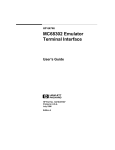
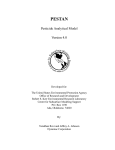

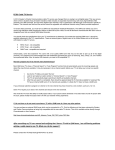
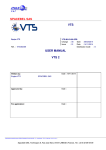
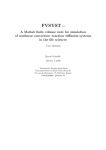
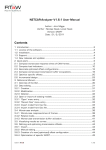

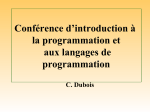

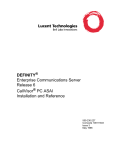
![[U4.90.21] Opérateur CALC_ESSAI_GEOMECA](http://vs1.manualzilla.com/store/data/006384770_1-86726a476700d772c164a2c913f13eb5-150x150.png)

